
Browse an alphabetical list of photographs. These historical images portray people, places, and events before, during, and after World War II and the Holocaust.
<< Previous | Displaying results 26-50 of 171 for "Photo" | Next >>
Defendant Adolf Eichmann takes notes during his trial in Jerusalem in 1961.
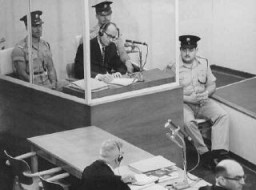
Defendant Adolf Eichmann identifies the city of Danzig (Gdansk) on a map during his trial in Jerusalem. Israel, July 18, 1961.
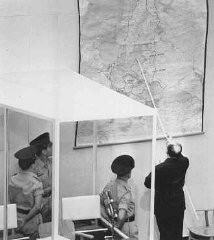
Defendant Alfred Jodl during the International Military Tribunal at Nuremberg. Jodl was Chief of the Armed Forces High Command Operations Staff.
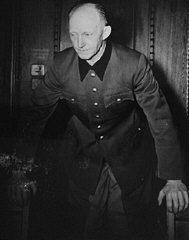
Fritz Sauckel follows the proceedings of the International Military Tribunal trial of war criminals at Nuremberg. He was found guilty of war crimes and crimes against humanity and was sentenced to death. Photograph taken in Nuremberg, Germany, between November 20, 1945, and October 1, 1946.
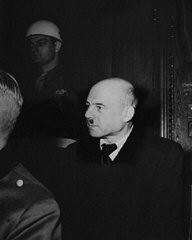
Defendant Julius Streicher, editor of the antisemitic newspaper Der Stürmer, on the stand at the International Military Tribunal trial of major war criminals at Nuremberg. April 29, 1946.
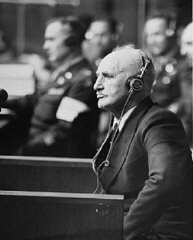
Defendant Julius Streicher in his prison cell at Nuremberg. For his influential role in inciting hatred and violence, the International Military Tribunal at Nuremberg indicated Streicher on count four, crimes against humanity. Streicher was found guilty and sentenced to death. He was hanged on October 16, 1946.
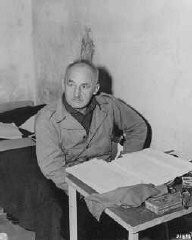
Defendant Julius Streicher, editor of the racist newspaper Der Stuermer. Streicher was one of the MT brought 24 leading German officials charged by the International Military Tribunal at Nuremberg.
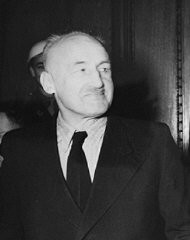
On September 15, 1947, defendant Paul Blobel pleads not guilty during his arraignment at the Einsatzgruppen Trial. Blobel was the commander of the unit responsible for the massacre at Babi Yar (near Kiev). He was convicted by the military tribunal at Nuremberg and sentenced to death. Blobel was hanged at the Landsberg prison on June 8, 1951.
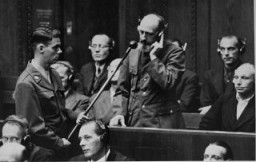
Among the many ironies of the International Military Tribunal was that the defendants were accorded that which they had denied their opponents: the protection of the law and a right to due process. Here, defendant Walther Funk, former German Minister of Economics, speaks with his defense attorney, Dr. Fritz Sauter, in a visitation room at Nuremberg.
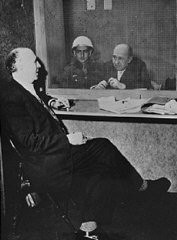
Defendant Wilhelm Keitel, former Chief of the German Armed Forces, in his Nuremberg prison cell.
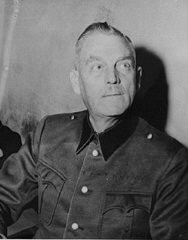
The defendants rise as the judges enter the courtroom at the International Military Tribunal trial of war criminals at Nuremberg.
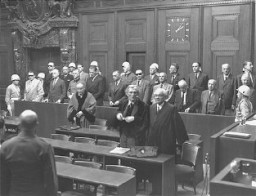
Defendants Wilhelm Keitel (left), Ernst Kaltenbrunner (middle), and Alfred Rosenberg (right), talk during a recess in the proceedings at the International Military Tribunal trial of war criminals at Nuremberg. Nuremberg, Germany, 1945–1946.
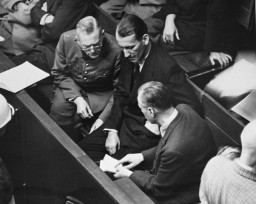
Birds-eye view of the fenced-in cell block where defendants in the International Military Tribunal war crimes trial were imprisoned. Nuremberg, Germany, between November 20, 1945, and October 1, 1946.
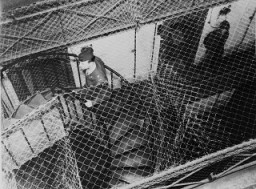
View of the defendants in the dock at the International Military Tribunal trial of war criminals at Nuremberg. November 1945.
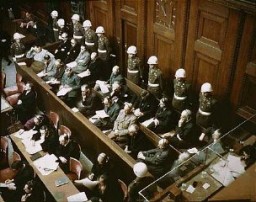
A group of the 19 men accused of committing atrocities at the Dora-Mittelbau concentration camp, located near Nordhausen, during their war crimes trial. Dachau, Germany, September 19, 1947.
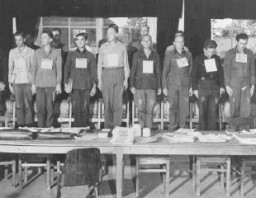
Visitors view the "Degenerate Art" exhibition (Entartete Kunst) at the Munich Hofgarten in July 1937. Works by Lovis Corinth and Franz Marc are visible, among others.

Delegates to the Evian Conference, where the fate of Jewish refugees from Nazi Germany was discussed. US delegate Myron Taylor is third from left. France, July 1938.
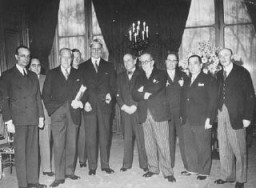
A post marked with Soviet symbols along the demarcation line between German- and Soviet-occupied Poland.
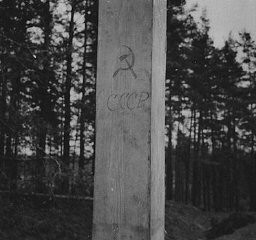
Two German sentries stand guard at Augustow on the demarcation line between Soviet- and German-occupied Poland. September 1939.
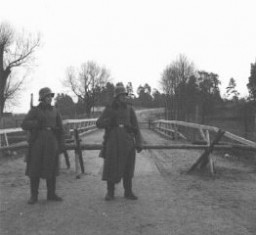
Defendant John Demjanjuk comments on documents being viewed on a large screen in court. Jerusalem, Israel, July 27, 1987.
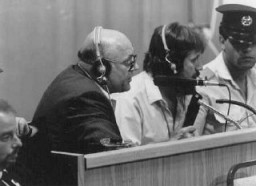
Defendant John Demjanjuk crosses his heart upon hearing the pronouncement of his death sentence. Jerusalem, Israel, April 25, 1988.

Survivors of the Dachau concentration camp prepare to move a corpse during a demonstration of the cremation process at the camp. Dachau, Germany, April 29–May 10, 1945. This image is among the commonly reproduced and distributed, and often extremely graphic, images of liberation. These photographs provided powerful documentation of the crimes of the Nazi era.
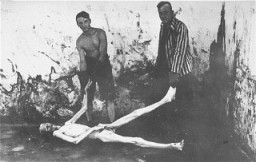
Survivors of the Dachau concentration camp demonstrate the operation of the crematorium by pushing a corpse into one of the ovens. Dachau, Germany, April 29–May 10, 1945. This image is among the commonly reproduced and distributed, and often extremely graphic, images of liberation. These photographs provided powerful documentation of the crimes of the Nazi era.
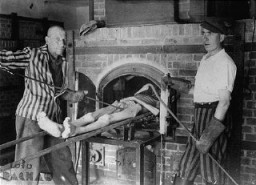
Survivors of the Dachau concentration camp demonstrate the operation of the crematorium by pushing a corpse into one of the ovens. Dachau, Germany, April 29–May 10, 1945. This image is among the commonly reproduced and distributed, and often extremely graphic, images of liberation. These photographs provided powerful documentation of the crimes of the Nazi era.

Survivors of the Dachau concentration camp demonstrate the operation of the crematorium by preparing a corpse to be placed into one of the ovens. Dachau, Germany, April 29–May 10, 1945. This image is among the commonly reproduced and distributed, and often extremely graphic, images of liberation. These photographs provided powerful documentation of the crimes of the Nazi era.
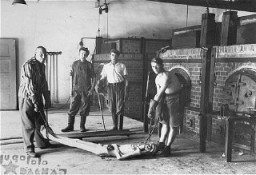
We would like to thank Crown Family Philanthropies, Abe and Ida Cooper Foundation, the Claims Conference, EVZ, and BMF for supporting the ongoing work to create content and resources for the Holocaust Encyclopedia. View the list of donor acknowledgement.